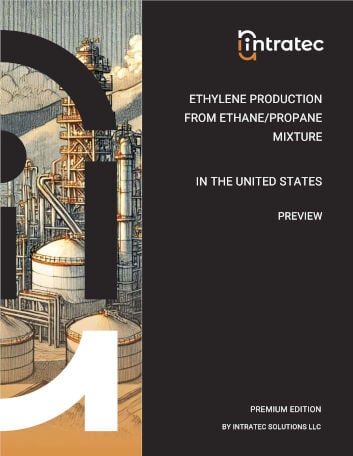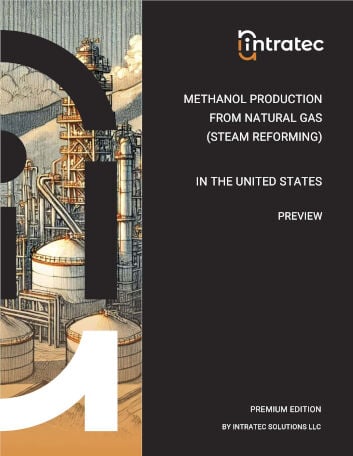Commodity Production Costs Report
Ethylene Production from Methanol
Ethylene Plant Capital & Operating Cost Analysis | United States | Q2 2025
This report presents the economics of polymer grade (PG) Ethylene production from methanol using a methanol-to-olefins (MTO) process. The process examined is similar to UOP/Norsk Hydro (now Ineos) MTO process. In this process, methanol is converted into dimethyl ether, which is further dehydrated to light olefins. In addition to Ethylene, polymer grade propylene is also generated as by-product in the process.
The report provides a comprehensive study of Ethylene production and related Ethylene production cost, covering three key aspects: a complete description of the Ethylene production process examined; an in-depth analysis of the related Ethylene plant capital cost (Capex); and an evaluation of the respective Ethylene plant operating costs (Opex).
The Ethylene production process description includes a block flow diagram (BFD), an overview of the industrial site installations, detailing both the process unit and the necessary infrastructure, process consumption figures and comprehensive process flow diagrams (PFD). The Ethylene plant capital cost analysis breaks down the Capex by plant cost (i.e., ISBL, OSBL and Contingency); owner's cost; working capital; and costs incurred during industrial plant commissioning and start-up. The Ethylene plant operating costs analysis covers operating expenses, including variable costs like raw materials and utilities, and fixed costs such as maintenance, labor, and depreciation.

The process under analysis comprises three major sections: (1) Reaction and regeneration; (2) Quench, compresion and caustic wash; and (3) Product fractionation.
Reaction and regeneration. Methanol feed is vaporized, mixed with recovered methanol, superheated and sent to the fluidized-bed reactor. In the reactor, methanol is first converted to dimethylether (DME) intermediate and then converted to olefins with a very high selectivity to ethylene and propylene. During the reaction, coke accumulates on the catalyst, which is circulated to the fluidized-bed regenerator system. In the regenerator, the coke is removed by combustion with air to keep the catalyst activity.
Quench, compression and caustic wash. The output from the reaction and regeneration is quenched, where most of water and non-reacted methanol is removed. The vapor stream from the quench stage is compressed and sent to a caustic wash column for CO2 removal. The gas stream free of CO2 is then dried and sent to next section.
Product fractionation. The dried stream is sent to the deethanizer column, where ethylene is separated from C3+ hydrocarbons as the overhead product. The ethylene rich stream is compressed and fed to the acetylene reactor for selective acetylene hydrogenation to ethane. The acetylene reactor effluent is sent to the demethanizer column, where an ethylene-ethane mixture is separated from a light stream. The C2 mixture is then routed to the C2 splitter, to obtain polymer grade (PG) ethylene product as the overhead. The C3+ stream is fed to the depropanizer column. The bottom product, composed mainly by C4+ hydrocarbons is sent to a debutanizer for recovering of mixed C4 and pyrolysis gasoline. The depropanizer column distillate, mainly containing a propylene-propane mixture, is fed to the C3 splitter column. In the C3 splitter, PG propylene is obtained as the overhead product.
Report in PDF Format
Download & Explore Anytime
Access in Various Devices
Print & Read Comfortably
Share With Co-workers
Up-to-date Report
Professional report based on Q2 2025 economic data, ensuring timely evaluations.
Multiple Use Cases
Ideal for investment screening, feasibility studies, cost estimates, and research planning.
Proven Methodology
Developed using a consistent methodology honed over a decade, ensuring reliable cost analyses.
Report Editions
Content Highlights
Plant Capital Cost Summary
Summary outlining the capital cost required for building the Ethylene production plant examined.
Plant Capital Cost Details
Detailing of fixed capital (ISBL, OSBL & Owner’s Cost), working capital and additional capital requirements.
Plant Cost Breakdowns
Breakdown of Ethylene process unit (ISBL) costs and infrastructure (OSBL) costs; plant cost breakdown per discipline.
Operating Costs Summary
Summary presenting the operating variable costs and the total operating cost of the Ethylene production plant studied.
Operating Cost Details
Detailing of utilities costs, operating fixed costs and depreciation.
Plant Capacity Assessment
Comparative analysis of capital investment and operating costs for different Ethylene plant capacities.
Production Process Information
Block Flow Diagram, descriptions of process unit (ISBL) and site infrastructure (OSBL).
Process Consumptions
Raw materials and utilities consumption figures, by-products credits, labor requirements
Process Diagrams
Process flow diagrams (PFD), equipment list and industrial site configuration
Other Ethylene Production Cost Reports

Ethylene Production from Ethane
This report presents the economics of Polymer Grade (PG) Ethylene production from ethane in the United States. In the process under analysis, ethane is thermally cracked in pyrolysis furnaces through the use of steam, yielding Ethylene. A hydrogen-rich gas is generated as by-product.
Details: 1200 kta United States-based plant | Q2 2025 | 107 pages | Issue B | From $799 USD

Ethylene Production from Ethane/Propane Mixture
This report presents the economics of Polymer Grade (PG) Ethylene production from ethane and propane in the United States. In the process under analysis, the mixture is submitted to a steam cracking process, yielding PG Ethylene. A hydrogen-rich gas and polymer grade propylene are generated as by-products,
Details: 1700 kta United States-based plant | Q2 2025 | 107 pages | Issue C | From $799 USD

Ethylene Production from Propane
This report presents the economics of Polymer Grade (PG) Ethlyene production from propane in the United States. In the study under analysis, propane is submitted through a steam cracking process, producing PG Ethylene. Pygas, a crude C4s stream, and PG propylene are generated as by-products.
Details: 1200 kta United States-based plant | Q2 2025 | 107 pages | Issue D | From $799 USD
Bundle & Save
Purchase multiple Ethylene Production Cost reports and enjoy tiered discounts
up to 30% off!
Could Not Find the Report You Need?
Obtain a Bespoke Report
Get a report targeting the process in which you are interested
See Offer Details
Understand Bespoke Reports and how you can easily order them
Check Editions & Pricing
Complete a brief form and see a quotation for your Bespoke Report
Other Related Production Cost Reports

Methanol Production from Natural Gas (Combined Reforming)
This study presents the economics of large-scale Methanol production from natural gas in the United States. In this process, natural gas is first converted into synthesis gas (syngas) by means of conventional steam reforming and secondary autothermal reforming. Then, the syngas is converted into Methanol.
Details: 1700 kta United States-based plant | Q2 2025 | 107 pages | Issue B | From $799 USD

Homopolymer HDPE from Ethylene (Similar to MarTECH Loop Slurry)
This report presents the economics of High Density Polyethylene (HDPE) production from polymer grade (PG) ethylene in the United States, using a slurry loop process similar to Chevron Phillips MarTECH and INEOS INNOVENE S. In this process, the monomers are polymerized in a single loop reactor.
Details: 450 kta United States-based plant | Q2 2025 | 107 pages | Issue F | From $799 USD

Propylene Production from Ethylene and Butenes
This report presents the economics of Polymer Grade (PG) Propylene production from ethylene and raffinate-2. The process under analysis consists in a metathesis process similar to Lummus Technology's Olefins Conversion Technology (OCT). The economic analysis performed assumes a plant located in the United States.
Details: 350 kta United States-based plant | Q2 2025 | 107 pages | Issue A | From $799 USD

Methanol Production from Natural Gas (Steam Reforming)
This study presents the economics of large-scale Methanol production from natural gas in the United States. In the process examined, natural gas is first converted into synthesis gas (syngas) by means of conventional steam reforming and then the syngas is converted into Methanol.
Details: 1000 kta United States-based plant | Q2 2025 | 107 pages | Issue A | From $799 USD
+800 Reports Developed, Targeting +250 Commodities
Vast Report Library
858 independent and up-to-date reports examining embryonic and established production processes.
Free Sample Reports
Quickly understand the structure and depth of content of our professional reports.

